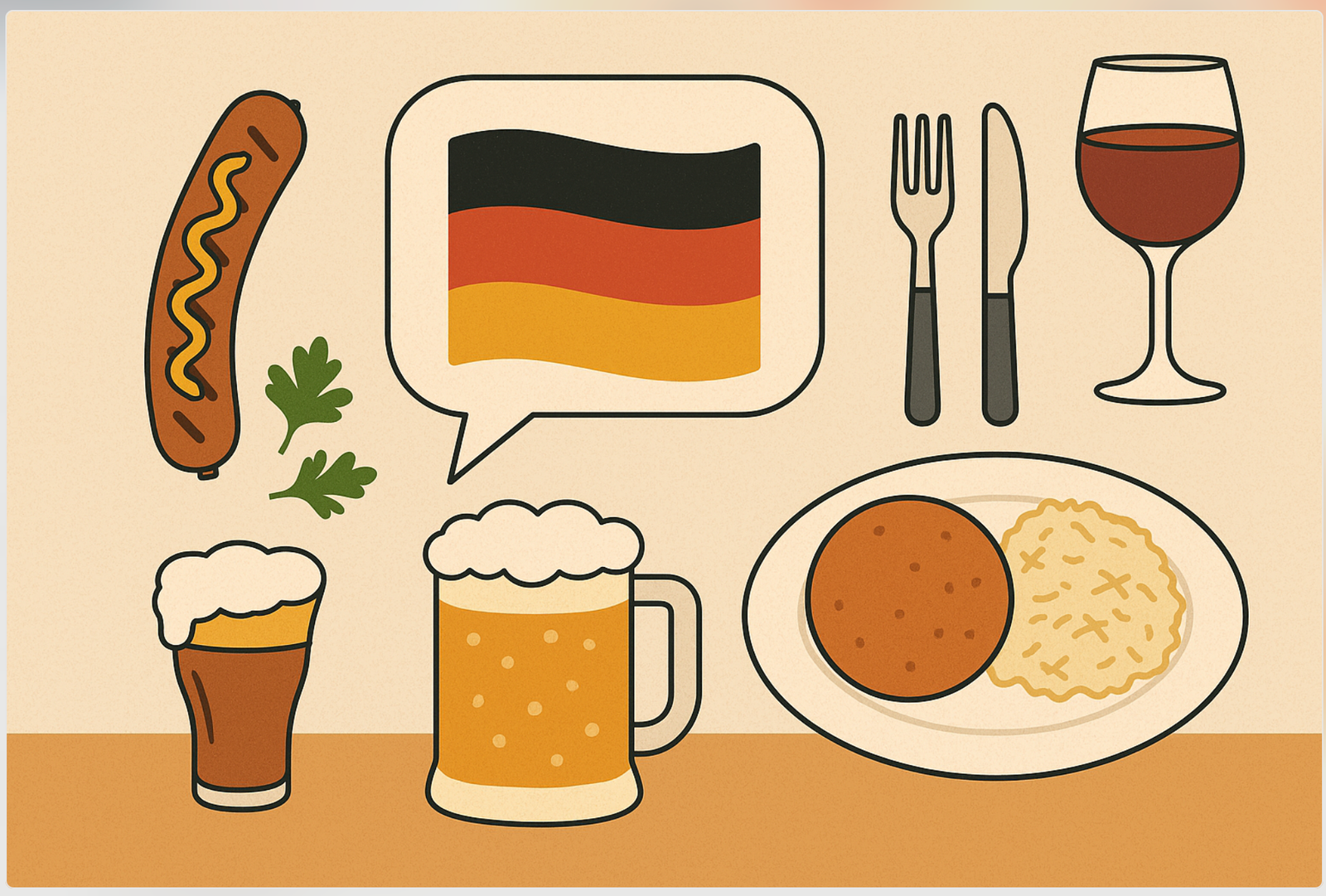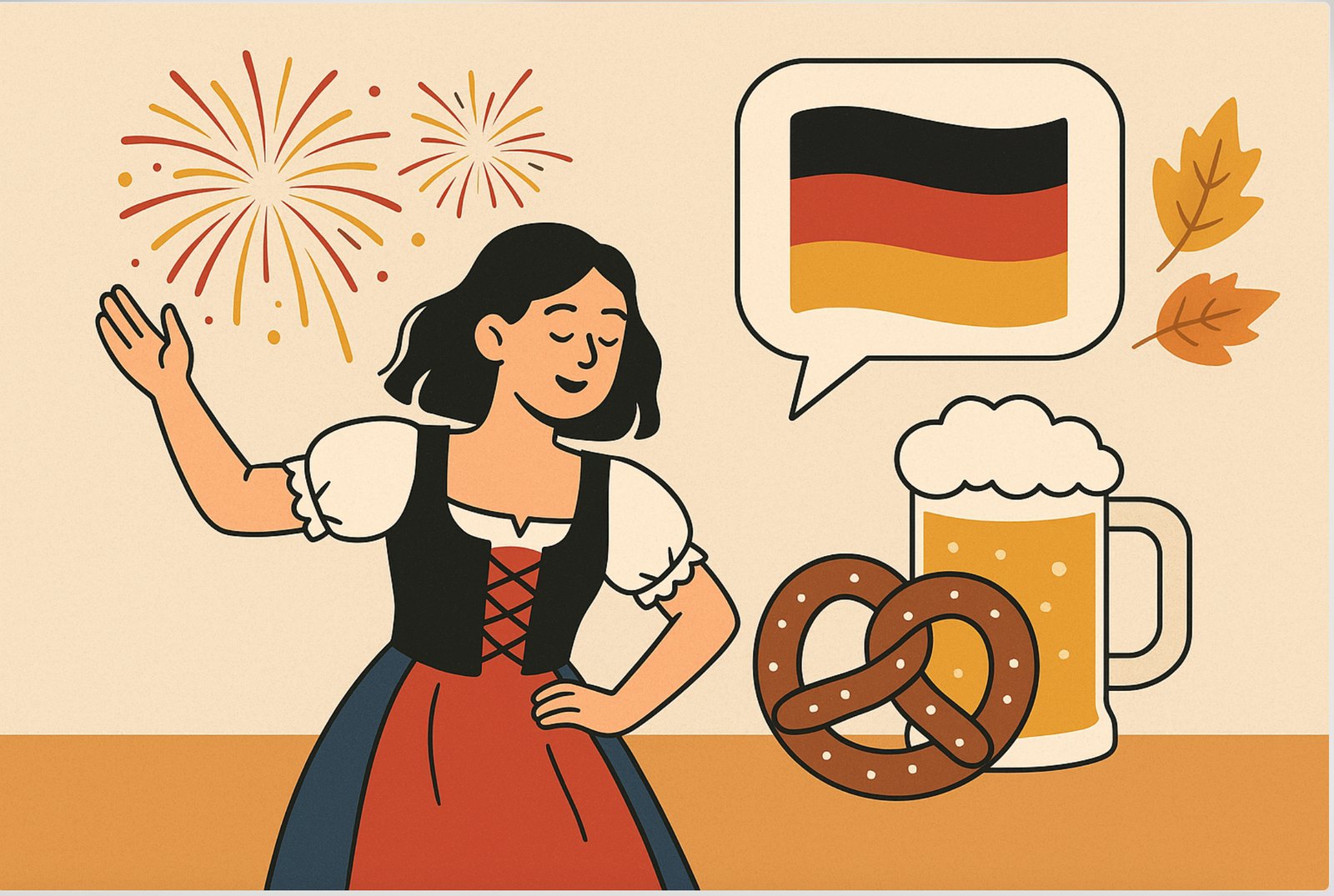Imagine wandering through the cobblestone streets of a quaint German village, the air laden with the tantalizing aroma of sizzling bratwurst and freshly baked pretzels. German food culture is as enchanting and multilayered as the country’s storied castles and picturesque landscapes. Beyond the mouth-watering delights that have made Germany a culinary destination, there is a rich tapestry of traditions and etiquette that shapes every dining experience. From the hearty comfort of sauerbraten to the intricacies of setting the perfect table, each meal offers an opportunity to immerse oneself in centuries-old customs that are still very much alive today.
While many are familiar with the iconic sights of Germany, such as the Brandenburg Gate or Neuschwanstein Castle, fewer have delved into the delicious depths of its culinary world. Partaking in German dining etiquette, for example, reveals much about the nation’s values: respect, community, and savoring the simple pleasures of life. So, whether you’re a culinary enthusiast eager to expand your palate or a curious traveler looking to understand the essence of German food culture, join us on this flavorful journey that promises to tantalize your taste buds and enrich your understanding of Germany’s delectable heritage.
The Heart of German Cuisine: Exploring Traditional Dishes
At the core of German food culture lies a remarkable array of traditional dishes that have been perfected over centuries. From the tender, slow-braised sauerbraten, with its balance of sweet and tangy flavors, to the crispy, golden schnitzel that graces countless tables, these culinary staples reflect regional ingredients and age-old techniques. Rooted in peasant ingenuity, many recipes began as simple ways to preserve meat and vegetables, evolving into the hearty, comforting fare we savor today.
Beyond meat-centric specialties, German cuisine boasts an impressive variety of side dishes and accompaniments. Think spaetzle—soft, dumpling-like noodles that soak up sauces—or red cabbage stewed with apples, vinegar, and spices, offering a vibrant counterpoint to richer mains. Potato salad, enjoyed warm or chilled, varies by region: the creamy southern style contrasts sharply with the tangier, vinegar-infused northern rendition. Each side dish tells a story of geography, climate, and historical trade routes that introduced new flavors and cooking methods.
In every corner of Germany, communal feasts and family gatherings highlight the importance of these time-honored recipes. Whether you’re enjoying the smoky notes of a charcoal-grilled bratwurst at a summer biergarten or settling in for a winter meal of hearty lentil soup with wiener, you’re participating in a cultural ritual. This enduring connection to the past underscores why German food culture continues to captivate both locals and international food enthusiasts alike.
Sausages Galore: A Deep Dive into the World of Bratwurst
Few foods define German food culture more than its vast selection of sausages, with bratwurst reigning supreme. Originating in Franconia, these cylindrical sausages are typically made from pork, veal, or beef, seasoned with nutmeg, mace, caraway, and garlic. Even within a single town, butcher shops often guard secret spice blends passed down through generations, resulting in subtle yet distinct flavor profiles.
Bratwurst’s versatility is part of its enduring appeal. Pan-fried until the casing crisps and the interior remains juicy, it’s commonly served in a crusty roll with mustard or alongside sauerkraut and potato salad. At outdoor markets and street fairs, vendors grill dozens of sausages at once, filling the air with their savory aroma. Yet, preparing bratwurst at home offers its own rewards: gently poaching the sausages in beer before grilling ensures tenderness, while finishing over live coals imparts an irresistible smokiness.
From the Nürnberger Rostbratwurst—small, thin, and protected by EU designation—to the hefty Thüringer Rostbratwurst, local pride fuels friendly rivalries among sausage enthusiasts. Sampling bratwurst across Germany is akin to a flavor-focused road trip, revealing regional ingredients and seasoning traditions. Whether enjoyed at Oktoberfest or a family barbecue, each sausage tells a story of community, craftsmanship, and a shared passion for robust, honest food.
Oktoberfest and Beyond: Festivals that Celebrate German Food
Germany’s festival culture is inseparable from its culinary traditions, and nowhere is this more apparent than at Oktoberfest. Held annually in Munich, this world-famous event stretches over two weeks, drawing millions of visitors eager to raise steins of beer and feast on hearty Bavarian specialties. Pretzels the size of your head, roasted chickens, and savory pork knuckles pair perfectly with frothy lager, epitomizing the festive spirit.
Beyond Munich’s grand beer halls, countless regional festivals honor local delicacies and seasonal harvests. In Cologne, the Frühjahrsvolksfest spotlights the city’s Kölsch beer and hearty dishes like Himmel un Ääd (mashed potatoes with apples and black pudding). Meanwhile, in the Rhineland, wine festivals celebrate the bounty of local vineyards, accompanied by Flammkuchen—thin-crust “tarte flambée” topped with cream, onions, and bacon.
These gastronomic events are more than mere showcases; they’re vibrant expressions of German food culture, where music, dancing, and folk costumes enrich the dining experience. Whether you’re dancing the polka in Bavaria or sampling smoked eel in northern Schleswig-Holstein, each festival offers a chance to connect with regional heritage, forging memories that last far beyond the final bite.
German Baking Traditions: From Pretzels to Black Forest Cake
German baking traditions are as varied as they are delicious. Few snacks are as iconic as the pretzel, its knotted shape symbolizing gratitude and prosperity. Crafted from simple ingredients—flour, water, yeast, and lye—this seemingly humble bread requires precise technique to achieve its glossy crust and chewy interior. Street vendors and bakery windows across Germany display pretzels alongside other savory delights, such as cheese-stuffed varieties or those topped with onions or sesame seeds.
On the sweeter side, the legendary Black Forest cake (Schwarzwälder Kirschtorte) showcases layers of chocolate sponge soaked in kirsch, interspersed with whipped cream and cherries. Originating from Baden-Württemberg, this elegant dessert has inspired countless variations and remains a staple at birthdays and special occasions. Another favorite, Stollen, is a fruit-laden Christmas bread dusted with powdered sugar, symbolizing the baby Jesus wrapped in swaddling clothes.
Germany’s rich baking heritage extends to countless regional specialties: Brezelschnecken (pretzel twists), Oblatenlebkuchen (wafer-thin gingerbread), and Berliner Pfannkuchen (jam-filled doughnuts), to name a few. Each confection reflects local customs, festive calendars, and centuries of experimentation, solidifying the country’s reputation as a paradise for pastry lovers and a vital component of German food culture.
Dining Etiquette Understanding the Rules and Customs
In Germany, meals are occasions to connect, converse, and appreciate the food on your plate. Dining etiquette is a reflection of respect, courtesy, and communal harmony. Before starting a meal, it’s customary to say “Guten Appetit,” signaling your intent to dine together. Keeping hands visible—resting wrists on the table—and using silverware for most dishes are staples of proper table manners.
Conversation at the table tends to be relaxed yet polite. Avoid controversial topics such as politics or religion unless you have built strong rapport. When sharing dishes, don’t reach across the table; instead, ask someone to pass the plate. If toasting, maintain eye contact and gently clink glasses with everyone before taking a sip. These small gestures embody the essence of German food culture—valuing community, respect, and a shared appreciation for good food.
Waiting for everyone to be served before eating is considered polite. When you’ve finished, placing your knife and fork parallel on the plate, with handles at four o’clock, signals you’re done. Proper etiquette enhances the dining experience, ensuring that every meal—be it a casual bratwurst at a beer garden or a formal multi-course dinner—honors the traditions that have shaped German food culture over centuries.
The Role of Beer: A Beverage deeply Rooted in German Culture
Beer is more than a drink in Germany; it’s a cultural institution. With over 1,300 breweries crafting more than 5,000 unique beer types, Germany’s brewing heritage is unmatched. From the crisp Pilsners of the north to the malty Bocks of Bavaria, each region showcases its own interpretation of the Reinheitsgebot, the 1516 purity law that originally allowed only water, barley, and hops in beer production.
In Bavaria, Märzen-style lagers—medium-bodied, amber-hued brews—are inextricably linked to Oktoberfest, yet beer halls operate year-round. Prost echoes through vaulted cellars as locals enjoy Maß (one-liter steins) alongside pretzels and Obatzda, a spiced cheese spread. Farther west, Kölsch in Cologne and Altbier in Düsseldorf demonstrate how subtle variations in yeast and fermentation create distinct flavor profiles.
Beer gardens and taverns serve as communal living rooms, reinforcing the central role of beer in German food culture. Families gather under chestnut trees, sharing platters and sampling regional brews. The ethos of Gemütlichkeit—a sense of warmth, friendliness, and belonging—is never more palpable than when a freshly tapped beer is placed before you, inviting conversation and connection.
Regional Specialties: Culinary Gems from Different Parts of Germany
Germany’s diverse landscapes yield an equally diverse culinary map. In the north, saltwater fish like herring and plaice feature prominently, often cured or pickled. Labskaus, a sailor’s hash of beef, potatoes, and beetroot, stands as a testament to coastal resourcefulness. Moving south into the heartland, Franconia is famed for its Schäufele (pork shoulder) crisped to perfection, while Swabia takes pride in Maultaschen—meaty pockets of pasta akin to ravioli.
The alpine south offers specialties rich in dairy and game. In Bavaria, wild boar stews and cheese dumplings reflect the region’s mountainous terrain and forested hunting grounds. Hesse, meanwhile, delights with Handkäse, a sour milk cheese typically served with onions and vinegar. During carnival season, the Rhineland enjoys Mutzenmandeln—sugar-dusted fritters—paired with strong coffee or community ales.
Each region’s dishes are shaped by history, economy, and climate, showcasing Germany’s culinary adaptability. Sampling these regional specialties is akin to exploring different chapters of German food culture—each bite reveals centuries-old practices, local ingredients, and a communal spirit that binds the nation together.
Modern Twists on Classic Dishes: Evolution of German Food
While German food culture cherishes tradition, a wave of creativity has reinvigorated classic dishes for modern palates. Chefs are experimenting with lighter ingredients and contemporary techniques, reinventing sauerbraten as seared beef medallions glazed with red wine reduction, or deconstructing Black Forest cake into layered parfaits with cherry gelée and chocolate soil.
Farm-to-table movements emphasize seasonal produce, prompting reinterpretations of hearty stews and dumplings. Veggie-forward adaptations, such as mushroom-based schnitzel or lentil “bratwurst,” cater to vegetarian and vegan diners without sacrificing authenticity. Fusion influences from Turkish, Italian, and Asian cuisines spark exciting combinations, like curry-spiced bratwurst or pretzel-crusted tofu bites.
These modern twists demonstrate that German food culture is not static but an evolving tapestry. By honoring the essence of their culinary heritage while embracing innovation, Germany’s chefs ensure that time-honored recipes remain relevant, delicious, and accessible to a global audience.
Ingredients Matter: The Importance of Quality in German Cooking
German cooks emphasize freshness and provenance, believing that superior ingredients form the backbone of any good dish. Regional markets overflow with seasonal produce—from asparagus in spring to pumpkins in autumn—encouraging home chefs to adapt menus according to nature’s calendar. Meat lovers seek out local butchers who raise free-range pigs and grass-fed cattle, ensuring humane practices and richer flavors.
Dairy products hold a special place, too: thick, tangy quark is used in spreads and desserts, while butter churned from pasture-fed cows lends depth to sauces and baked goods. Artisanal breads, baked in wood-fired ovens, showcase the country’s commitment to centuries-old techniques. Even carryover products like sauerkraut and pickles are often made in-house using family recipes, reflecting an understanding that food preservation methods shape both taste and nutrition.
By prioritizing quality ingredients, German food culture celebrates transparency and sustainability. When you savor a dish made with freshly milled rye flour or sip a beer brewed with locally harvested hops, you’re tasting the results of a mindful, ingredient-focused approach that honors the land and its people.
Embracing Gemütlichkeit: How German Food Culture Emphasizes Comfort and Togetherness
Gemütlichkeit—a word that captures warmth, friendliness, and a sense of belonging—lies at the heart of German dining experiences. Mealtime is rarely rushed; instead, it’s an invitation to linger over conversations, share laughs, and forge connections. Communal tables in beer gardens or family-style dishes at home reinforce the idea that food is best enjoyed together.
Whether gathered around a crackling fireplace for a winter fondue or picnicking under spring blossoms with picnic baskets of Wurst and Käse, the spirit of Gemütlichkeit permeates every setting. It’s a celebration of simple pleasures: a hearty meal, a good drink, and the company of friends or strangers who become friends. This ethos elevates each culinary encounter beyond mere sustenance, making it a memorable expression of German hospitality and communal joy.
Conclusion
From the robust flavors of bratwurst to the refined art of German baking, German food culture offers a captivating blend of history, tradition, and innovation. Every dish, festival, and dining custom reflects a deep respect for quality ingredients and communal values that have endured for generations.
By understanding the etiquette, regional specialties, and modern adaptations that shape this culinary landscape, we gain insight into a culture that treasures togetherness, respect, and the simple joy of a shared meal. Embark on your own gastronomic adventure and discover how German food culture continues to delight and inspire food lovers around the world.



Leave a Reply